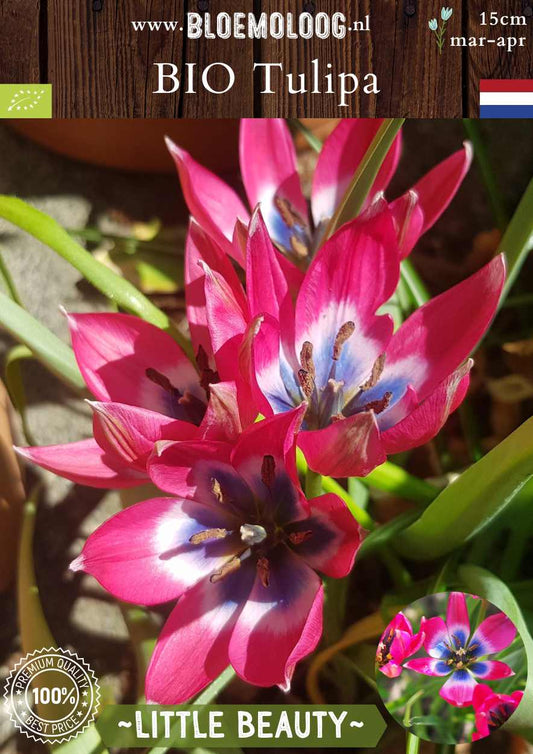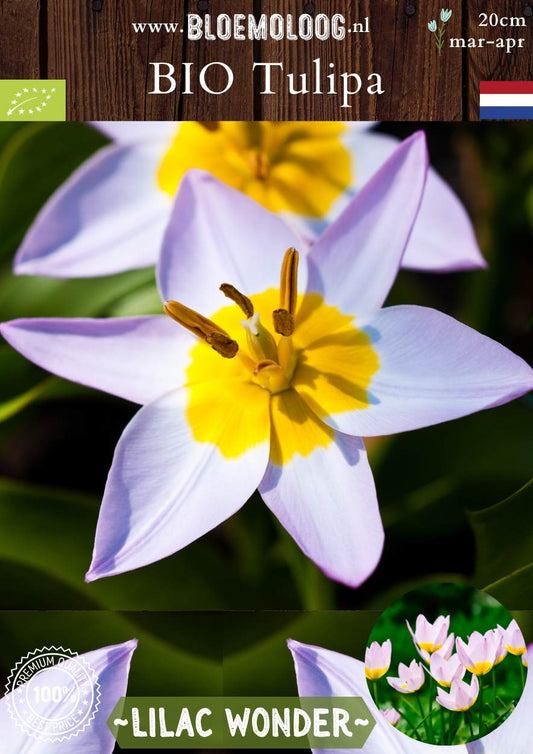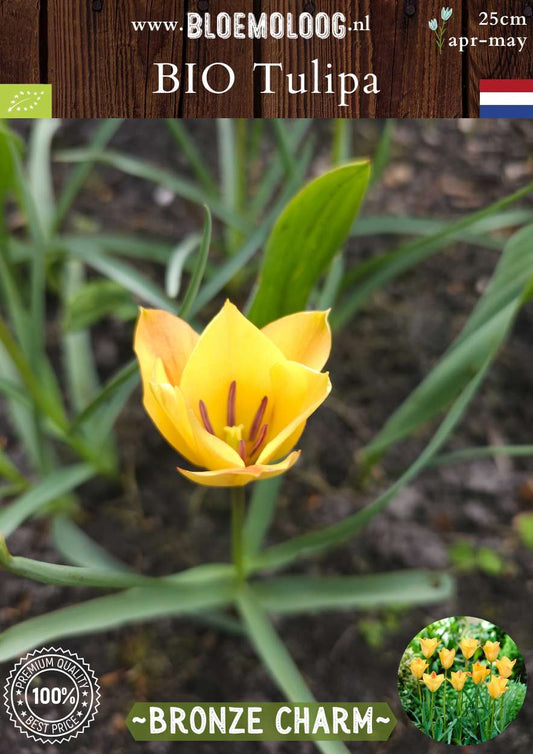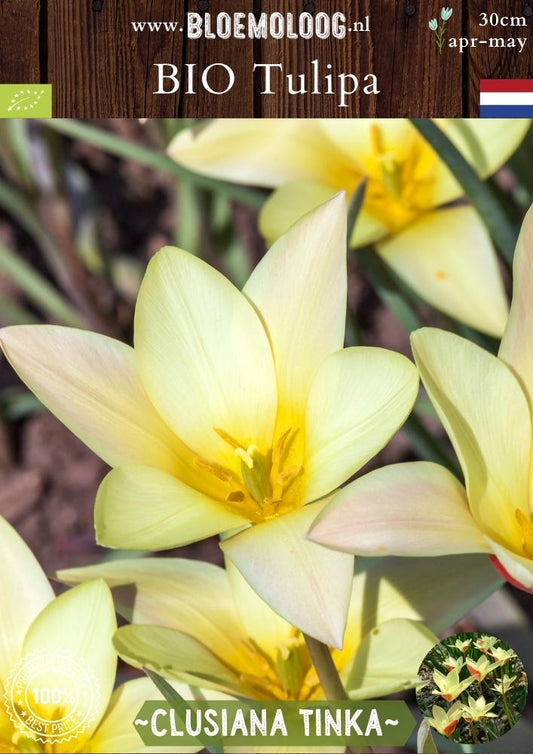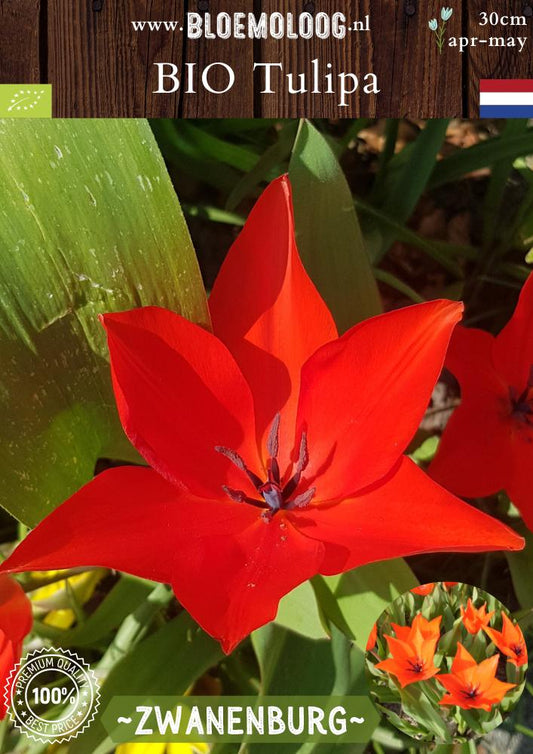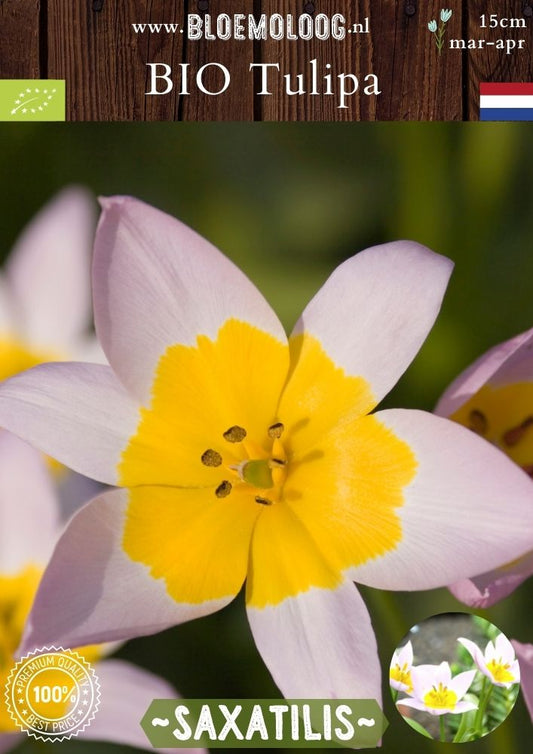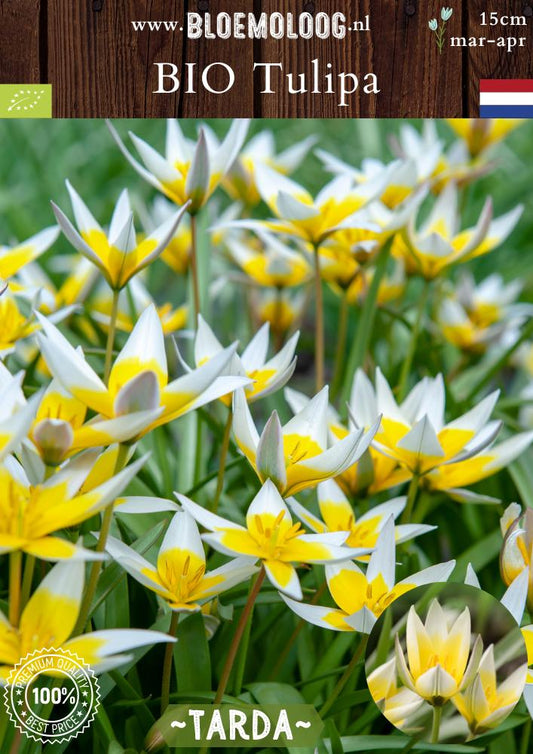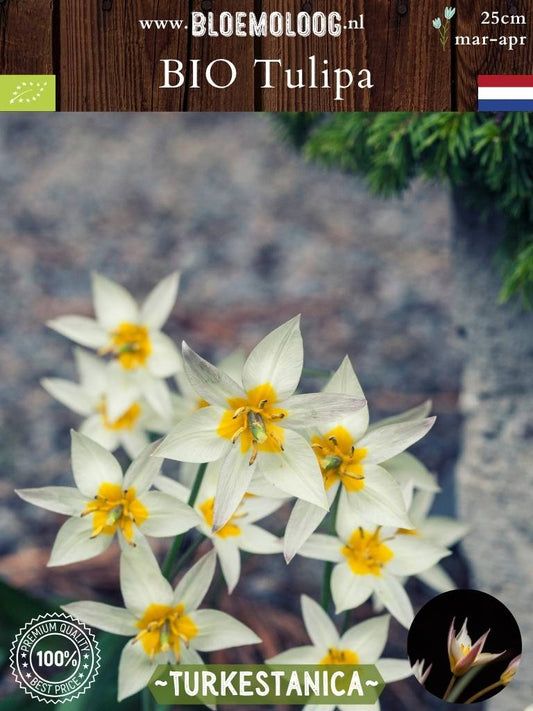
Collection: Organic botanical tulips
What are botanical tulips
Botanical tulips are also called specie tulips or wild tulips. They are tulips that are closer to the original, wild species than the more well-known, large hybrid tulips. They are usually smaller and lower than the classic tulips and have a natural, graceful appearance. They are one of the first known tulips that have also been found in Dutch gardens for hundreds of years.
Where do I plant botanical tulips?
Most wild tulips prefer a sunny location in a water-permeable, chalky soil. However, the Tulipa 'Sylvestris', also called woodland tulip , is suitable for acidic soil in, for example, woodland gardens. Most botanical tulips remain low and sometimes produce multiple flowers per flower bulb. The Tulipa clusiana 'Tinka' grows slightly higher with a height of 30 centimetres
Which tulips come back every year?
Botanical tulips, also called naturalising tulips, are disease-resistant and better able to withstand bad weather conditions. This makes them easy to naturalise and also multiply. They are maintenance-free and return faithfully to the same location every year, without having to be transplanted every year like hybrid tulips. When the flower bulbs grow above ground after a while, they can be replanted in the ground at the correct planting depth, so that they are well covered with soil.
Organic botanical tulips
For several years now, wild tulips have been grown organically in collaboration with nature. This means that chemical pesticides and artificial fertilizers are not necessary. The bees and bumblebees will buzz around the garden even more happily in early spring.
Where can I buy botanical tulips?
At Bloemoloog.nl from June to January organically grown flower bulbs of botanical tulips for sale. Botanical tulips are available on the market from the end of July.
-
Organic Muscari 'Armeniacum' & Tulipa 'Lilac Wonder' mix | 20 pieces
Regular price €9,90Regular priceUnit price €0,50 / per item -
Organic Tulipa 'Little Beauty & Tarda' mix (botanical) - Wild tulips | 50 pcs.
Regular price €19,95Regular priceUnit price / per -
Organic Tulipa 'Little Beauty' (botanical) - Wild tulip | 10 pcs.
Regular price €4,99Regular priceUnit price €0,50 / per item -
Organic Tulipa 'Saxatilis' & Muscari 'Armeniacum' mix | 20 pcs.
Regular price €9,90Regular priceUnit price / per -
Bio Tulipa bakeri 'Lilac Wonder' - Botanical | 10 pcs.
Regular price €4,95Regular priceUnit price €0,50 / per item -
Organic Tulipa batalinii 'Bronze Charm' (botanical) - Wild tulips | 10 pcs.
Regular price €4,95Regular priceUnit price / per -
Organic Tulipa batalinii 'Yellow Jewel'
Regular price €5,95Regular priceUnit price €0,60 / per item -
Organic Tulipa clusiana 'Taco' (botanical) - Wild tulip | 10 pcs.
Regular price €4,95Regular priceUnit price €0,50 / per item -
Organic Tulipa clusiana 'Tinka' (botanical) - Wild tulip | 10 pcs.
Regular price €4,95Regular priceUnit price €0,50 / per item -
Organic Tulipa praestans 'Zwanenburg' | 10 pcs.
Regular price €4,95Regular priceUnit price / per -
Organic Tulipa saxatilis (botanical) - Wild tulip | 10 pcs.
Regular price €4,95Regular priceUnit price €0,50 / per item -
Organic Tulipa sylvestris (botanical) - Woodland tulip | 10 pcs.
Regular price €5,95Regular priceUnit price €0,60 / per item -
Organic Tulipa tarda (botanical) - Wild tulip | 10 pcs.
Regular price €4,95Regular priceUnit price €0,50 / per item -
Organic Tulipa turkestanica | 10 pcs.
Regular price €4,95Regular priceUnit price €0,50 / per item
-
Organic spring bulbs
Spring-flowering bulbs and tubers are popular plants that produce beautiful flowers from early spring through summer. Because of their early bloom, they combine well with perennials when they still need to establish themselves.
Tulips are probably the most well-known spring flowers. They come in many different colors, shapes, and sizes. Daffodils are known for their cheerful yellow flowers, but they also come in other colors like white and orange. Crocuses are small bulbous plants with striking flowers in shades of purple, yellow, and white. They are often the first flowers to appear in spring. Hyacinths have fragrant flowers in various colors, such as pink, purple, blue, and white. They are often planted in borders, flower beds, or pots.Benefits of organic spring bulbs
When you choose organic flower bulbs that bloom in spring, you can be sure that no chemicals or pesticides will end up in your garden. These pesticides are harmful to bees and prevent them from finding their nests. As a result, more and more bee species have been added to the red list in recent years. Together, we can do something about this!
Flower bulbs for wild bees
Did you know that wild bees lay eggs in their nests, which then hatch in early spring? These newborn insect helpers immediately search for food in the surrounding area. There are also insects that have hibernated and are desperately looking for a hearty breakfast: the blooming flowers where nectar and pollen can be found! Just after winter, there's little greenery or food for these insects. Planting early-blooming flower bulbs ensures there's food available, and the insects can gain strength for the coming summer.
Organic growers
The organic growers we work with cultivate not only the most beautiful but also the strongest products. They cultivate varieties and species of flowers and plants that experience has shown to be virus-resistant, so they don't need to use chemicals and pesticides. Organic growers seek natural remedies and solutions against diseases and/or pests. All our flower bulbs are certified organic; both the Florist and the growers are SKAL-certified.
When do you plant spring bulbs?
Spring-flowering bulbs can be planted from autumn until January. Bulbs that need to be dug up in the summer after flowering should be dug up starting in late July and stored until the next planting season in autumn.
What to do after flowering
When spring bloomers have finished blooming, cut off the wilted flowers at the top of the stem. Let the rest of the plant die back naturally so it can still receive maximum energy from the sun.
How do you store spring bulbs?
If you've purchased flower bulbs from us and had them delivered to your home and would like to leave them for a while, we recommend opening the box and storing it in a ventilated, cool place until you're ready to plant them.
Store flower bulbs you dig up after flowering in a warm place, such as a shed. To prevent mice from eating the bulbs during this period, you can also hang them in a bag or pantyhose. -
Where is the best place to plant spring bulbs?
Spring-flowering bulbs are flowers that bloom in the spring, between January and July. There are many different types of spring-flowering bulbs, suitable for different types of gardens and soil. For example, some bulb plants enjoy catching a glimpse of the sun during flowering, but prefer to be covered by a tree during their dormant period in summer.
Spring bloomers in the sun
Many spring bloomers need plenty of sun to bloom and grow well for the following year. These flowers thrive in full sun:
Spring bloomers in the shade
Some spring bloomers also grow and bloom well in the shade, such as:
Spring bloomers in moist soil types
There are also flower bulbs that can be planted in moist soil. Some varieties from the Florist's collection include:
Conclusion
There are many different types of spring bloomers suitable for different types of gardens and soil. Whether a spring bloomer can grow in sun or shade depends on the specific variety. Some prefer dry soil, while others prefer wet feet. So, there's a suitable spring bloomer for every garden.
Tips for a flowery garden
Plant a variety of flowers, each with its own blooming time, so there are flowers blooming throughout the spring and food for bees and other insects in your garden. Would you also like to arrange your garden/bed so you can enjoy flowers all spring long, and the bees too? Feel free to send us a message or ask us at the market stall. We're happy to help! Promote biodiversity in your garden and enjoy the first flowers and colors after the cold and dark winter!
Order spring bloomers in advance
Pre-sales for spring-flowering bulbs will begin on June 1st in the Bloemoloog webshop.
During the pre-sale, you can pre-order your desired products. This way, you can be sure your favorite flowers are still in stock, and we'll ship your package with PostNL as soon as planting time arrives.
Flower bulbs ordered in the pre-sale will be delivered in mid-September. From then on, they can be planted directly in the garden or in containers on the balcony.




